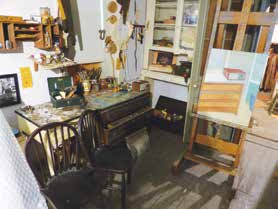Errors of Estate Heirs – Ask The Artsperts

Juliana Meek and Kristine Meek
Dear Artsperts:
I’m just curious, what happens to unsold paintings when an artist dies? Got any horror stories from your Gallery’s half century plus in the art business?
Signed,
Errors of Heirs
Dear Errors,
Having been in business as a gallery since January of 1964, we have represented hundreds of artists and/or their estates.

David Maril, son of artist Herman Maril, has perfectly preserved his father’s studio in hopes of it becoming a museum someday. David Maril is interested in preserving his father’s legacy long into the future.
Like the Farmers Insurance commercials, we’ve seen almost everything, and we’ve experienced virtually every conceivable variation of an artists’ career, but perhaps the most difficult for us to predict, justify, or to be pleased with has come when an artist passes away, or later their surviving spouse.
At that decisive moment in an artist’s ‘career, matters can move smoothly into the next era or be set back for scores of years with the artist’s reputation destroyed indefinitely.
Our experience with artists passing began in our first year in business with the passing of Jon Corbino in 1964 and goes through 2017 with the passing of Bob Kane’s widow. And yes, we have stories, but we won’t name names.
One artist had one surviving child who decades before had been committed to an insane asylum for attempting to murder him. The artist feared the state would seize all his artwork and hold a “fire sale to cover the costs of caring for his son, because his wife had predeceased him.
Like so many inheritance horror stories, he named his caretaker, who drove him to his appointments, heir to his estate. The caretaker had no knowledge of art, but at his request we shipped to him the 450 unsold consigned works of art. The caretaker eventually died and left the body of works to a distant relative, who then put all the paintings into storage. Then, twenty years after the artist’s death, this new heir sold the entire estate in a local two-day antiques auction at a fraction of what the art was worth.

Juliana Meek between Andrea and Andy Lowe, one of the heirs of the Adolf and Virginia Dehn estate. Andy Lowe promotes the work of his uncle and aunt by working with museums for exhibitions, galleries for artist representation and
art historians for publications of books and articles. The estates are in a trust he manages along with his siblings.
Ironically, the auction took place in an old fire station. The artist’s career was burned by the decades of inactivity and by the auction, even though he was at one time a highly respected American master. Another artist had three surviving children, who each inherited one-third of the estate. Instead of pooling the paintings and dividing future sales by one-third, two of the three decided they didn’t want to sell anything, but didn’t mind if the other sold her paintings.
As a result, she said she didn’t want to sell either. There was no memorial exhibition – for sale or just exhibition, no museum shows, and the works have remained in the separate possession of these three heirs and their heirs.
Without solo exhibitions and sales, there is nothing to keep the artist in the public eye for the last thirty years, resulting in yet another American master lost to the archives. In another case, the widow of an artist left the paintings of her late husband to more than two dozen distant relatives and friends spread around the globe. You can imagine how well that went.
There are examples of smart things artists have done to protect both their work and their reputation long after their death. Some have made significant contributions of their artwork to art museums across the county to be used as exhibitions that promote their work in perpetuity.
Others have placed all of their works in a trust or a foundation before passing away. There are examples, too, of heirs who deeply care about learning more about their parent or relative’s career and their artwork. In these cases, heirs fully understand that they have inherited the responsibility of managing the remaining body of works well into the future, so the artist is not lost to history.
Fortunately, not every story is a horror story.
Sincerely,



Leave a Reply
Want to join the discussion?Feel free to contribute!